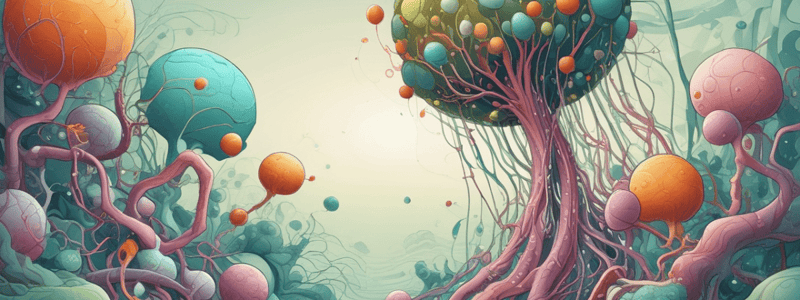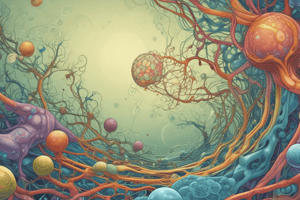Podcast
Questions and Answers
What is the primary function of the lysosome?
What is the primary function of the lysosome?
- Temporary storage or secretion of materials
- Protein and lipid synthesis
- Energy production from nutrients
- Debris degradation and contents recycling (correct)
What is the role of the centrioles in the cell?
What is the role of the centrioles in the cell?
- Synthesis of proteins and lipids
- Involvement in DNA replication and transcription
- Involvement in the process of mitosis (correct)
- Organization of the nucleolus
What is the result of unchecked DNA damage in cells?
What is the result of unchecked DNA damage in cells?
- Improved quality control of proteins and lipids
- Enhanced cellular activity and synthesis
- Disruption of embryonic development and increased risk of cancer (correct)
- Increased energy production from nutrients
What is the primary function of the chloroplast's internal membrane system?
What is the primary function of the chloroplast's internal membrane system?
What is the function of the pars fibrosa in the nucleolus?
What is the function of the pars fibrosa in the nucleolus?
What is the main function of the mitochondria in a cell?
What is the main function of the mitochondria in a cell?
What is the primary function of the Golgi apparatus?
What is the primary function of the Golgi apparatus?
What is the primary function of the lysosomes in a cell?
What is the primary function of the lysosomes in a cell?
What is the function of the nucleolus in the nucleus?
What is the function of the nucleolus in the nucleus?
What is the main function of the cytoskeleton in a cell?
What is the main function of the cytoskeleton in a cell?
What is the primary function of the ribosomes in a cell?
What is the primary function of the ribosomes in a cell?
What is the primary function of the endoplasmic reticulum in a cell?
What is the primary function of the endoplasmic reticulum in a cell?
What is the primary function of the peroxisome in the cell?
What is the primary function of the peroxisome in the cell?
Which of the following is NOT a function of the Golgi body?
Which of the following is NOT a function of the Golgi body?
What is the consequence of uncontrolled release of lysosomal enzymes into the cytoplasm?
What is the consequence of uncontrolled release of lysosomal enzymes into the cytoplasm?
Which of the following is a characteristic of lysosomal enzymes?
Which of the following is a characteristic of lysosomal enzymes?
What is the name of the protein that is lacking in Adrenoleukodystrophy (ALD)?
What is the name of the protein that is lacking in Adrenoleukodystrophy (ALD)?
What is the primary function of the nucleolus in the cell?
What is the primary function of the nucleolus in the cell?
Which organelle is characterized by having many internal folds and being rich in enzyme systems vital to energy production?
Which organelle is characterized by having many internal folds and being rich in enzyme systems vital to energy production?
What is the primary source of genetic material for mitochondrial DNA?
What is the primary source of genetic material for mitochondrial DNA?
What is the result of a deficiency in the lysosomal enzyme responsible for breaking down fatty substances in Tay-Sachs disease?
What is the result of a deficiency in the lysosomal enzyme responsible for breaking down fatty substances in Tay-Sachs disease?
Which of the following is NOT a symptom of mitochondrial disease?
Which of the following is NOT a symptom of mitochondrial disease?
What is the primary function of the three components of the cytoskeleton?
What is the primary function of the three components of the cytoskeleton?
Which of the following organs is NOT typically affected by mitochondrial disease?
Which of the following organs is NOT typically affected by mitochondrial disease?
What is the primary mechanism by which ions and small hydrophilic molecules pass through the membrane?
What is the primary mechanism by which ions and small hydrophilic molecules pass through the membrane?
Which of the following molecules can pass through the membrane by simple diffusion?
Which of the following molecules can pass through the membrane by simple diffusion?
What is the consequence of cell necrosis?
What is the consequence of cell necrosis?
What is the role of GLUT in cellular transport?
What is the role of GLUT in cellular transport?
What is the characteristic feature of chromatin in apoptotic cells?
What is the characteristic feature of chromatin in apoptotic cells?
What is the fate of the cell fragments formed during apoptosis?
What is the fate of the cell fragments formed during apoptosis?
Flashcards are hidden until you start studying
Study Notes
Lysosomes and Cellular Functions
- Primary function of lysosomes: digestion and waste removal through hydrolytic enzymes.
- Consequence of uncontrolled release of lysosomal enzymes: can lead to cell damage and death.
- Characteristic of lysosomal enzymes: active in acidic environments and designed to break down macromolecules.
Centrioles
- Role of centrioles: organize the microtubule system during cell division and form spindle fibers.
DNA Damage
- Result of unchecked DNA damage: can lead to mutations, cancer, or programmed cell death (apoptosis).
Chloroplasts and Energy Production
- Primary function of chloroplast's internal membrane system: site for photosynthesis, containing thylakoids where light reactions occur.
Nucleolus and its Functions
- Function of the nucleolus: ribosomal RNA (rRNA) synthesis and ribosome assembly.
- Location of pars fibrosa: within the nucleolus, involved in the transcription of rRNA.
Mitochondria
- Main function of mitochondria: ATP production through oxidative phosphorylation; powerhouse of the cell.
- Mitochondrial DNA: primarily inherited maternally and involved in energy production gene expression.
- Organelle with internal folds rich in enzyme systems: mitochondria, enhancing surface area for energy-producing reactions.
Golgi Apparatus
- Primary function of the Golgi apparatus: modification, sorting, and packaging of proteins and lipids for secretion or delivery to other organelles.
Cytoskeleton
- Main function of the cytoskeleton: provides structural support, facilitates cell movement, and organizes cell components.
- Primary functions of the three components of the cytoskeleton (microtubules, microfilaments, intermediate filaments): maintain cell shape, enable intracellular transport, and anchor organelles.
Endoplasmic Reticulum
- Primary function of the endoplasmic reticulum: synthesis of proteins (rough ER) and lipids (smooth ER), as well as detoxification.
Peroxisomes
- Primary function of peroxisomes: breakdown of fatty acids and detoxification of hydrogen peroxide.
Apoptosis
- Characteristic feature of chromatin in apoptotic cells: condensation and fragmentation.
- Fate of cell fragments during apoptosis: engulfed by phagocytes, preventing inflammation.
Membrane Transport
- Primary mechanism for ions and small hydrophilic molecules: channel proteins or transporters.
- Molecules that can pass through the membrane by simple diffusion: nonpolar molecules, such as oxygen and carbon dioxide.
Cellular Transport and Necrosis
- Role of GLUT in cellular transport: facilitates glucose uptake into cells.
- Consequence of cell necrosis: uncontrolled cell death resulting in tissue damage and inflammation.
Tay-Sachs Disease
- Result of deficiency in the lysosomal enzyme responsible for breaking down fatty substances: accumulation of GM2 gangliosides, leading to neurological damage.
Mitochondrial Disease
- Organs typically affected by mitochondrial disease: often includes the brain, muscles, and heart.
- Symptoms not typically associated with mitochondrial disease: may vary, often include metabolic dysfunctions.
Studying That Suits You
Use AI to generate personalized quizzes and flashcards to suit your learning preferences.




